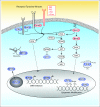Unraveling the molecular pathophysiology of myelodysplastic syndromes
- PMID: 21220588
- PMCID: PMC3969457
- DOI: 10.1200/JCO.2010.31.1175
Unraveling the molecular pathophysiology of myelodysplastic syndromes
Abstract
Somatically acquired genetic abnormalities lead to the salient features that define myelodysplastic syndromes (MDS): clonal hematopoiesis, aberrant differentiation, peripheral cytopenias, and risk of progression to acute myeloid leukemia. Although specific karyotypic abnormalities have been linked to MDS for decades, more recent findings have demonstrated the importance of mutations within individual genes, focal alterations that are not apparent by standard cytogenetics, and aberrant epigenetic regulation of gene expression. The spectrum of genetic abnormalities in MDS implicates a wide range of molecular mechanisms in the pathogenesis of these disorders, including activation of tyrosine kinase signaling, genomic instability, impaired differentiation, altered ribosome function, and changes in the bone marrow microenvironment. Specific alterations present in individual patients with MDS may explain much of the heterogeneity in clinical phenotype associated with this disease and can predict prognosis and response to therapy. Elucidation of the full complement of genetic causes of MDS promises profound insight into the biology of the disease, improved classification and prognostic scoring schemes, and the potential for novel targeted therapies with molecular predictors of response.
Conflict of interest statement
Authors' disclosures of potential conflicts of interest and author contributions are found at the end of this article.
Figures


References
-
- Haase D, Germing U, Schanz J, et al. New insights into the prognostic impact of the karyotype in MDS and correlation with subtypes: Evidence from a core dataset of 2124 patients. Blood. 2007;110:4385–4395. - PubMed
-
- Look AT: Molecular pathogenesis of MDS. Hematology Am Soc Hematol Educ Program. 2005:156–160. - PubMed
-
- Gondek LP, Haddad AS, O'Keefe CL, et al. Detection of cryptic chromosomal lesions including acquired segmental uniparental disomy in advanced and low-risk myelodysplastic syndromes. Exp Hematol. 2007;35:1728–1738. - PubMed
-
- Bejar R, Ebert BL. The genetic basis of myelodysplastic syndromes. Hematol Oncol Clin North Am. 2010;24:295–315. - PubMed
Publication types
MeSH terms
Substances
Grants and funding
LinkOut - more resources
Full Text Sources
Other Literature Sources
Medical
Research Materials
Miscellaneous

